Pillar Pages, What Is It And How To Use It
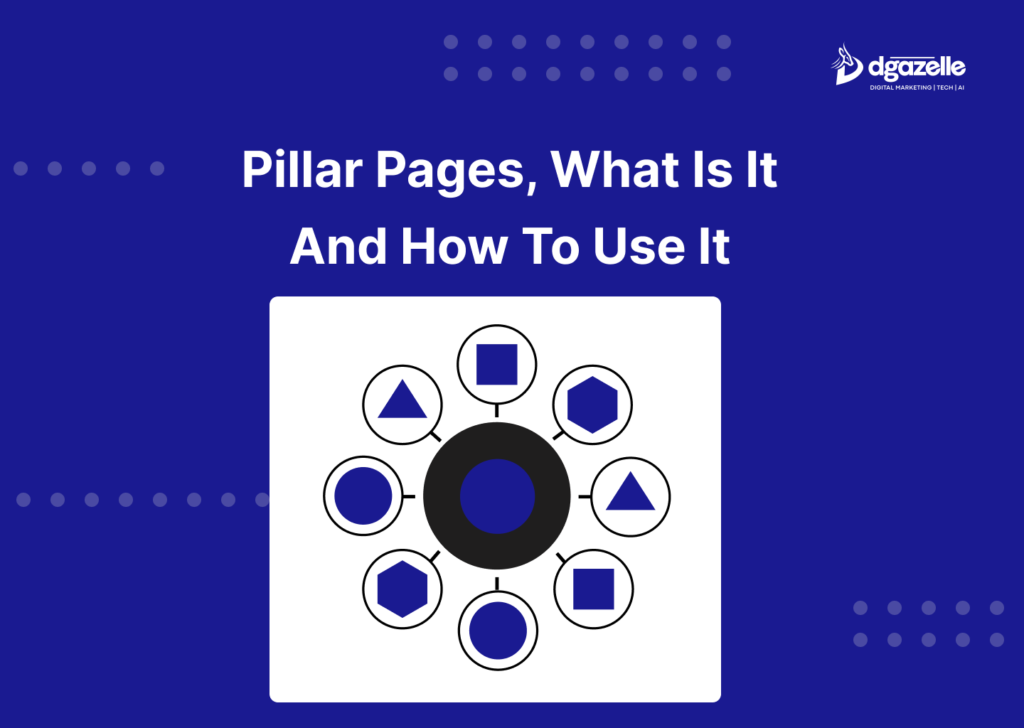
Ever felt lost in a sea of online content, struggling to find clear, structured information? That’s where pillar pages come in. A pillar page is a comprehensive, authoritative guide on a broad topic, serving as the foundation of a well-organized content strategy. It links to more specific, related content—known as topic clusters—making it easier for search engines to understand your site and for users to find exactly what they need. For Nigerian business owners looking to improve their website’s visibility and engagement, pillar pages can be game-changers. When done right, they can boost traffic, enhance user experience, and increase conversions. But if implemented poorly, they can actually harm your SEO. What Is a Pillar Page, Exactly? Think of a pillar page as the foundation of your content strategy, the main hub that connects and organizes related topics in a structured way. It’s a comprehensive guide that introduces key themes while linking to in-depth articles (topic clusters) for further exploration. More than just a content piece, a well-crafted pillar page enhances SEO by establishing context, relevance, and authority in search engines. When properly implemented, it boosts rankings, improves user experience, and keeps visitors engaged longer key factors for any Nigerian business looking to dominate its industry online. How Long Should a Pillar Page Be? Pillar pages are not your average blog post. They are in-depth, authoritative, and typically 2,000+ words long. But length isn’t the goal value is. These pages must cover a topic thoroughly, answering key questions while guiding users to more specific subtopics. However, a pillar page alone won’t cut it. Just like a bicycle’s wheels rely on spokes for stability, pillar pages draw their strength from supporting cluster content. Why Should You Use Pillar Pages? Pillar pages are essential because they make your website more organized, helping both search engines and users navigate your content seamlessly. A structured approach not only enhances the user experience but also improves your Google ranking. Google favors websites with logical hyperlink structures that clearly define content relationships. By strategically linking supporting articles to a central pillar, you signal relevance and expertise in your niche. Moreover, the more thoroughly you cover a topic, the stronger your authority. A well-executed pillar page positions your business as an industry leader, helping you attract and convert more customers online. How to Create an Effective Pillar Page Creating a pillar page isn’t just about writing, it’s about strategy. Here’s how to build one that ranks well and delivers value. Need help optimizing your website’s content structure? Dgazelle’s content experts craft high-ranking pillar pages that turn visitors into leads. Let’s build your authority! Step #1: Choose the Right Topics Start with keyword research. Tools like Ubersuggest, Google Trends, and AnswerThePublic help you find relevant topics and analyze competitor strategies. But don’t just rely on tools, listen to your audience. Use social media, surveys, and online forums to discover their biggest pain points and questions. Competitor analysis can also highlight content gaps, topics your competitors aren’t covering well, giving you an edge. Pro Tip: Refresh older content by turning it into a pillar page, expanding it with relevant subtopics for a stronger content structure. Lastly, stick with evergreen topics, ones that stay relevant long-term, so your effort keeps paying off. Step #2: Use Keyword Research to Organize Your Content Keyword research isn’t just about rankings—it’s about structuring your pillar page for clarity and relevance. Start by listing high-volume, business-relevant keywords using tools like Ubersuggest, Google Keyword Planner, or AnswerThePublic. Prioritize LSI (latent semantic indexing) keywords to improve search visibility. How Keywords Strengthen Your Pillar Page Take inspiration from Investopedia’s pillar page on home buying—it covers every angle, offers actionable steps, and links to supporting content. Want a powerful SEO strategy for your business? Dgazelle’s expert content team can structure your website for maximum visibility and engagement. Step #3: Create Your Pillar Page and Supporting Content Now that you’ve laid the groundwork, it’s time to build your pillar page and supporting content. Keep these best practices in mind: 1. Prioritize Quality and Readability Your pillar page isn’t just a content hub—it should be engaging and valuable on its own. Make it scannable with:Bulleted lists for key points, Short paragraphs to improve readability, Images and visuals to break up text, Logical structure with clear sections 2. Link Strategically 3. Follow Google’s E-E-A-T Principles Your content should reflect Experience, Expertise, Authoritativeness, and Trustworthiness to rank better and build credibility. Step #4: Build Backlinks to Your Pillar Pages You’ve created a solid pillar page, but your job isn’t done yet! Now, it’s time to amplify its reach through backlinks, one of the strongest SEO ranking factors. Start by auditing your current backlinks using Ubersuggest’s backlink checker to analyze the number of backlinks you already have, the domain authority of referring sites, and the spam score to avoid low-quality links. Once you have this data, focus on securing quality backlinks by reaching out to industry bloggers and relevant websites to feature your content, writing guest posts for high-authority websites with links back to your pillar page, and joining trusted business directories like Nigeria’s Chamber of Commerce. Conclusion A well-structured pillar page isn’t just a content piece, it’s a powerful SEO tool that enhances user experience, boosts authority, and strengthens link-building efforts. By organizing your content around pillar pages, you create a seamless navigation path for visitors while signaling relevance to search engines. This structure fills content gaps, improves engagement, and increases visibility in search results. Think of pillar pages as the backbone of your content strategy, the stronger they are, the more support they provide to your entire website. Ready to take your SEO game to the next level? Don’t just wait for customers to find you—put your brand in front of them! Let’s craft an outbound marketing strategy that drives results. Get a Free Strategy Session Today!
The SEO Blindspot Costing Nigerian Businesses Millions: Zero Click Searches
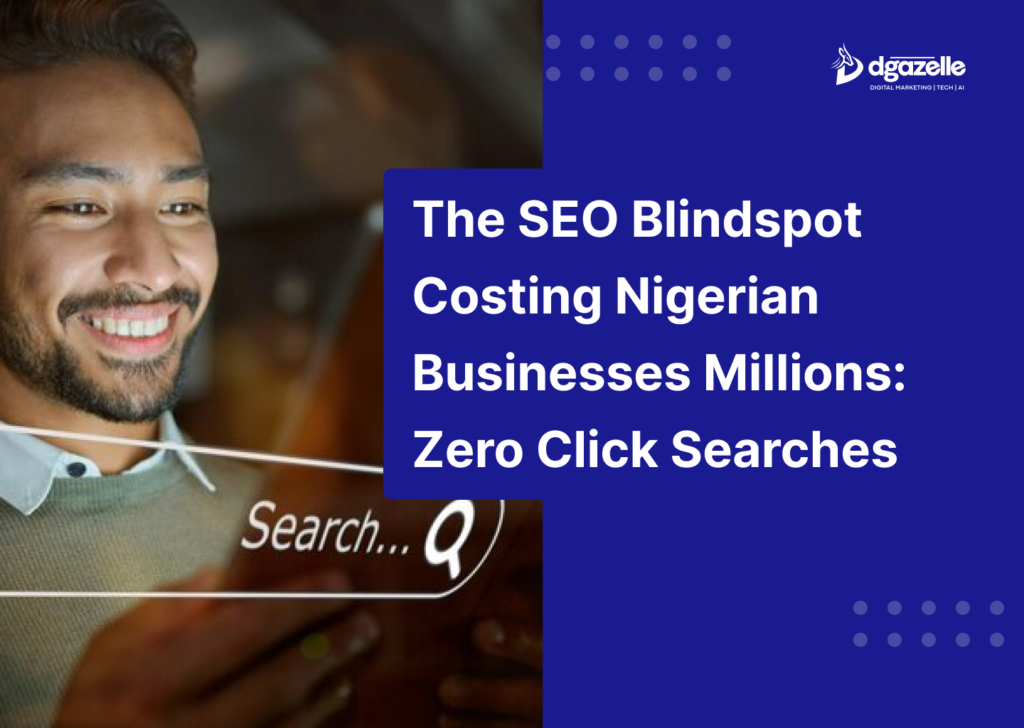
The way people search online is changing, and Nigerian businesses that rely on SEO to drive traffic and sales may be losing out—without even realizing it. The culprit? Zero click searches. Every day, millions of Nigerians turn to Google for answers. But instead of clicking on a website, they get their answers directly on the search engine results page (SERP) and move on. No website visits. No conversions. No sales. If your business depends on organic search traffic, this trend could be silently costing you leads and revenue. But the good news? With the right SEO strategy, you can turn zero click searches into an opportunity rather than a loss. What Are Zero Click Searches? Zero click searches happen when users find the information they need directly on Google’s SERP without clicking on any website. For example, if someone searches for today’s exchange rate or “best phones under ₦100,000,” Google might display the result instantly—pulling data from third-party sources. You’ve likely done this yourself when checking football scores, flight statuses, or definitions. While zero click searches improve user experience, they reduce website traffic—which means fewer potential customers, less ad revenue, and missed sales opportunities. And with 62.41% of searches now ending with zero clicks (up from 54.11% in 2017), businesses need to adapt fast. The big question is: How do you stop losing traffic to zero click searches—and turn them in your favor? But first why is it happening Why Zero Click Searches Are Growing Zero click searches aren’t just a passing trend—they’re becoming the new normal, and businesses that rely on organic traffic need to take action. A study by SparkToro’s Rand Fishkin, using Datos’s clickstream analysis, revealed that 58.5% of U.S. searches and 59.7% of European searches resulted in zero clicks. The same pattern is growing in Nigeria as search engines evolve. So, why are clicks declining? 1. Google’s Own Features Are Taking Over Google now answers most searches directly on the results page with AI Overviews, featured snippets, and knowledge panels. Instead of clicking on a website, users get instant responses—costing businesses valuable traffic. Beyond that, Google is sending more traffic to its own platforms, like: 2. People Are Searching Beyond Google Websites aren’t just competing with Google anymore. Consumers are finding content on: How Nigerian Businesses Can Win in the Age of Zero Click Searches How users find answers directly on search engine results pages (SERPs) without clicking through to a website—are changing the SEO procedure. Businesses must adapt by focusing on structured data, local search, and multi-platform visibility to maintain traffic and brand awareness. Zero click searches aren’t going away, but the right SEO strategy ensures your business still gets noticed and converts visitors into customers. Need an SEO strategy tailored to your business? Let’s talk! 1. Implement Schema Markup Schema markup is structured data that helps search engines and AI-driven models understand and display your content effectively. By implementing the right schema types, you improve your chances of appearing in zero click search results like featured snippets and product listings. Here are key schema types to prioritize: Using schema markup increases the likelihood of Google recognizing and surfacing your content in prominent SERP positions. 2. Strengthen Local SEO For businesses with a physical presence or service area, optimizing for local search is crucial. Local SEO strategies help brands appear in search features such as map packs, knowledge panels, and local featured snippets. Here are key actions to improve local search visibility: By focusing on local SEO, businesses can improve their chances of being featured in high-visibility SERP positions for location-based searches. 3. Track and Adjust Your SEO Strategy To measure the effectiveness of your zero click search strategy, continuous monitoring is essential. Rank tracking tools provide insights into performance, showing whether content adjustments are needed. Using a tool like Ubersuggest’s Rank Tracking, businesses can: If rankings decline or stagnate, revisiting content strategies—such as improving clarity, updating information, or adding structured data—can help regain visibility. 4. Expand Beyond Google with Search Everywhere Optimization Search behavior is evolving, with users increasingly seeking answers on multiple platforms beyond traditional search engines. To maintain visibility, businesses must optimize for different channels, including: By diversifying search presence, businesses can reach audiences across multiple platforms, reducing dependence on traditional organic search traffic. Conclusion: Future-Proof Your SEO with Smart Strategies As zero click searches continue to grow, businesses must embrace a multi-faceted SEO approach. Implementing structured data, optimizing for local search, tracking performance, and expanding search visibility across platforms will ensure continued success in an evolving digital world. By adapting to these changes now, businesses can maintain relevance, increase brand awareness, and drive meaningful engagement despite the shift in search behavior. Ready to drive more organic traffic? Dgazelle’s proven SEO strategies will improve your rankings and boost conversions. Let’s elevate your website today
What is SEO Crawl Budget And Why Is It Important
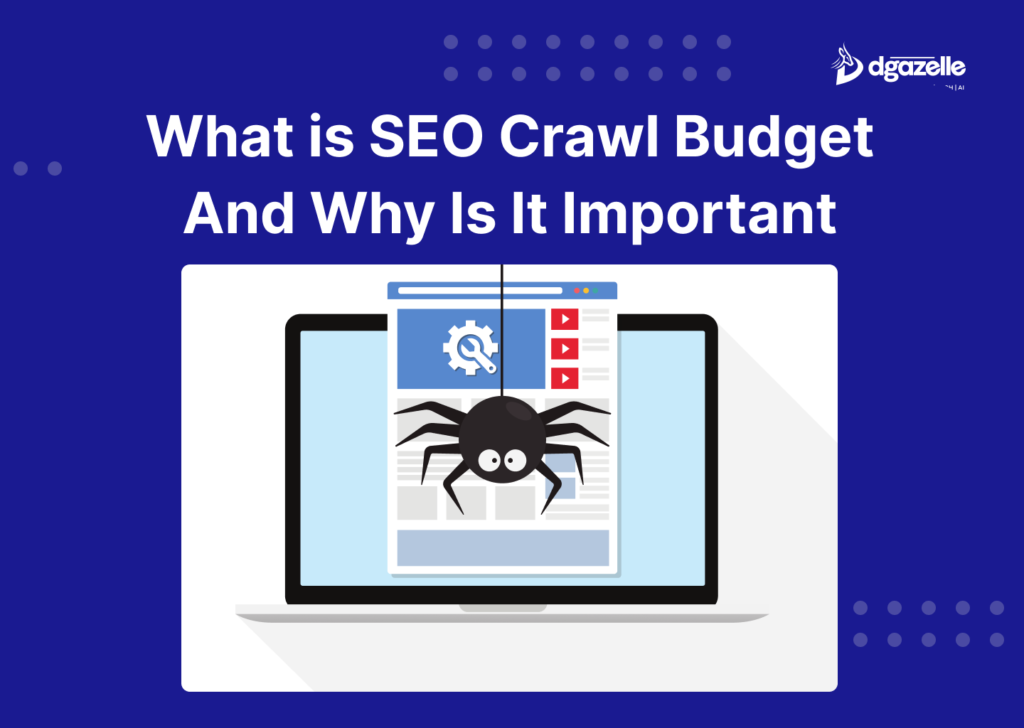
Understanding your website’s SEO crawl budget is crucial, especially for business owners in Nigeria looking to boost their online presence. In simple terms, crawl budget is the number of URLs on your website that search engines like Google will discover and crawl within a specific time frame. Once that quota is met, the search engine moves on to other sites. Here’s the thing: with billions of websites on the internet, search engines have limited resources. They can’t check every single site every day, so they prioritize which pages to crawl and when. This means that if your site isn’t optimized, important pages might not be indexed quickly or at all, potentially impacting your search rankings. For Nigerian businesses, ensuring that search engines efficiently crawl your site can lead to faster discovery of new content and improved visibility in search results. At Dgazelle, we understand the unique challenges and opportunities of the Nigerian market. That’s why our web design services not only focus on creating visually appealing and user-friendly websites but also incorporate best SEO practices. By designing your site with a clear crawl structure and optimized content, we help ensure that search engines find and index your pages effectively—giving your business the competitive edge it needs in the digital space. Before diving into the strategies that search engines use to decide what to crawl, let’s explore why managing your crawl budget is so vital for your site’s overall SEO success. Why is SEO Crawl Budget Important for your website? For your website to rank in Google’s search results, it first needs to be crawled and then indexed. This process allows Google to discover and store data about your pages, ultimately impacting their visibility. If something goes wrong with these processes, your content may never appear in search results. When Google’s web crawlers visit your site, they go through several steps: crawling pages, fetching data, storing it, and sending it back to the index. The efficiency of this process plays a significant role in your search rankings and can directly affect your organic traffic—ultimately impacting your business goals. For most website owners, crawl budget isn’t a major concern because Google is generally efficient at crawling sites. However, there are specific scenarios where understanding crawl budget becomes crucial for SEO performance: For Nigerian business owners, optimizing crawl budget is a way to ensure that your site remains competitive in search results, especially in a fast-growing digital market like Nigeria. At Dgazelle, we specialize in creating websites that not only look great but are technically sound to ensure efficient crawling by search engines. Our web design services focus on resolving potential crawlability issues and structuring your site for optimal performance. This means your content is more likely to rank higher, bringing you more visibility and ultimately driving business growth. By managing crawl budget effectively, you can ensure your content is indexed promptly, which leads to better search engine visibility and more organic traffic—vital for your business’ success in today’s competitive online landscape. How Does Google Determine Crawl Budget? Google determines your website’s crawl budget based on two primary factors: Crawl Demand and Crawl Capacity Limit. Understanding these factors can help Nigerian business owners optimize their site for better SEO performance. Optimize your site’s performance today with Dgazelle! Our expert web design services ensure better crawl efficiency and faster load times. Get in touch now! 1. Crawl Demand Crawl demand is how often Googlebot crawls your site, and it’s influenced by three key elements: 2. Crawl Capacity Limit Crawl capacity refers to how much Googlebot can crawl before your site’s performance is impacted. This is mainly determined by your website’s health and Google’s own crawling limits. For Nigerian business owners, it’s essential to maintain a healthy website to ensure smooth crawling. At Dgazelle, we prioritize website speed, server reliability, and SEO best practices to help ensure your site is easy for Googlebot to crawl, keeping your crawl budget intact. By understanding and managing these two factors, you can ensure that Google crawls your website efficiently, leading to faster indexing and improved SEO performance. This, in turn, can lead to higher search rankings and more organic traffic, helping your business thrive online. Why Should You Care About Crawl Budget? For Nigerian business owners aiming to enhance their online presence, understanding and optimizing crawl budget is essential. Here’s why: You want search engines like Google to find and understand as many of your indexable pages as possible. When you add new content or update existing pages, it’s crucial that search engines pick them up quickly. The sooner they’re indexed, the sooner you can start benefiting from that content through organic search traffic. However, if you’re not managing your crawl budget efficiently, Googlebot may waste time crawling unnecessary pages, leaving your important content undiscovered. If Google doesn’t know about your key pages, they won’t crawl and index them. This results in missed opportunities to attract visitors to those pages through search engines, which can severely impact your business’ SEO performance. Wasting crawl budget hurts your SEO, as search engines may not prioritize your essential pages, affecting your site’s ranking and visibility. But don’t worry—crawl budget management becomes particularly important if you have a large website (e.g., 10,000+ pages). For smaller sites, it’s typically not as big of a concern. Regardless, optimizing your crawl budget is a smart move for businesses of all sizes aiming for strong online visibility. Let Dgazelle help you create a website that’s built for search engines and users. Contact us for a strategy session! Tips for Crawl Budget Optimization Conclusion Regularly optimizing your site’s technical aspects ensures web crawlers can efficiently find your content, which is essential for ranking in search results. By using tools like Semrush’s Site Audit, you can monitor your site’s health and address errors before they impact performance. This proactive approach helps you maximize your crawl budget, improve SEO, and ultimately boost your site’s visibility. Maximize your crawl budget with a high-performance website from Dgazelle. Our team ensures
Orphan Pages Killing Your SEO? Here’s How to Find and Fix Them
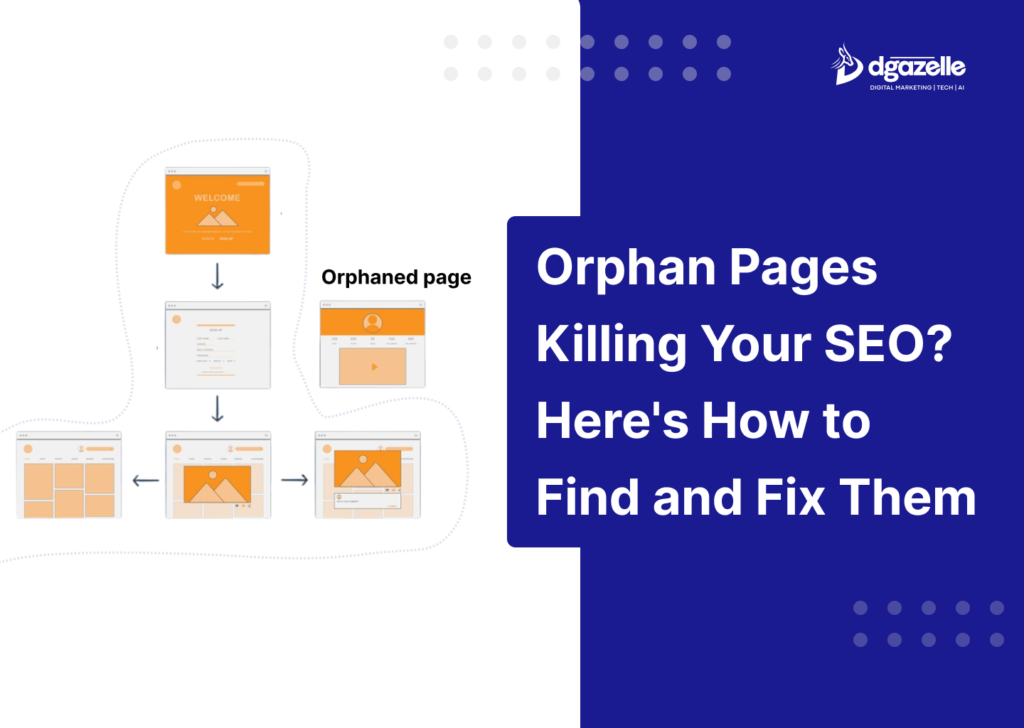
When we talk about orphan pages, we’re referring to web pages that exist on your site but aren’t linked to from any other page. This means users and search engines have a hard time finding them. For Nigerian SME owners, this is crucial because if potential customers can’t discover your best content, you’re missing out on sales and visibility. Orphan pages aren’t necessarily bad for SEO, but they don’t contribute to your site’s overall content strategy. You could have top-notch content on these pages, but without internal links guiding users and search engines to them, they serve little purpose. Sometimes, orphan pages are created intentionally—like landing pages used in paid ads. These pages are usually set up to be hidden from search engines with tags like “noindex, nofollow,” which is perfectly fine. But for your main website, every valuable page should be easy to find and accessible to users and search engines. What Exactly Are Orphan Pages? Orphan pages are web pages on your site that have no internal links pointing to them from any other page—be it your homepage, blog posts, category pages, or navigation menu. This means users and search engines can’t easily discover them. But it goes beyond that. If a page is only linked from other orphan pages, it’s still considered an orphan. For example, if Blog Posts B and C are linked only from Post A, and Post A itself is orphaned, then B and C are also orphans. They’re isolated from the main site structure, making them invisible to search engines and users navigating from your homepage. For Nigerian SMEs, this can be a big problem. Hidden pages mean missed business opportunities, as potential customers won’t find your valuable content or products. When Is It Okay to Have Orphan Pages? Not all orphan pages are bad. In fact, some are intentional. These include: These pages are usually hidden from search engines with “noindex, nofollow” tags and don’t need to be part of your main site structure. As long as this is strategic and intentional, it’s perfectly fine. What Causes Orphan Pages? Orphan pages often occur unintentionally, but they can also be deliberate.Common Causes Include: Intentional Orphan Pages:Some orphan pages are purposefully isolated, like: As long as these are strategic, they’re okay. Just make sure they’re excluded from search engine indexing. Why Are Orphan Pages Bad for SEO? Google and other search engines discover new content by following internal links. If a page is orphaned, search engines won’t find it unless it’s in your sitemap or has backlinks. No Internal Links = No PageRankPageRank is Google’s way of understanding a page’s importance based on the number and quality of links pointing to it. Without internal links, an orphan page can’t receive any “link juice” or PageRank, impacting its SEO performance. For Nigerian SMEs, this means valuable content or product pages could be hidden from potential customers, ultimately affecting your bottom line. How to Find Orphan Pages on Your Website Finding orphan pages requires a thorough approach using multiple tools and methods. Here’s how to get it done: 1. Using SEO Crawling Tools These tools can identify orphan pages even if they’re not linked internally by comparing the site’s crawl data with your sitemap. Combining these tools provides a comprehensive view of orphan pages on your site. 2. Using GA4 and Search Console This approach also helps discover low-performing pages for future content improvement. 3. Manual Site Audit This is the most accurate but time-consuming method. Hiring a dedicated SEO Agency to help keep on top of things like this could also save you time. The experience they have will mean they are always looking out not just for issues with orphan pages, but hundreds of other things that could also be impacting your organic visibility. 4. Backlink Analysis Tools to Use: How to Fix Orphan Pages on Your Website Once you’ve identified the orphan pages, fixing them is straightforward. Here are two effective methods: 1. Adding Internal Links If the orphan page is valuable and relevant: 2. Remove and Redirect If the orphan page is outdated or no longer relevant: Why It Matters: A 301 redirect preserves link equity and ensures users land on a relevant page, maintaining a positive user experience. Conclusion All content on your website should have a purpose for both users and SEO. If a page is orphaned it becomes arguably useless for them both. If you have any other methods you use for finding orphan pages, we’d love to hear them. Boost your online presence and grow your business with Dgazelle’s expert social media and digital marketing services. From creative strategies to tailored campaigns, we’ve got you covered.
Marketing That Works, Even Without a Solid Social Media Presence
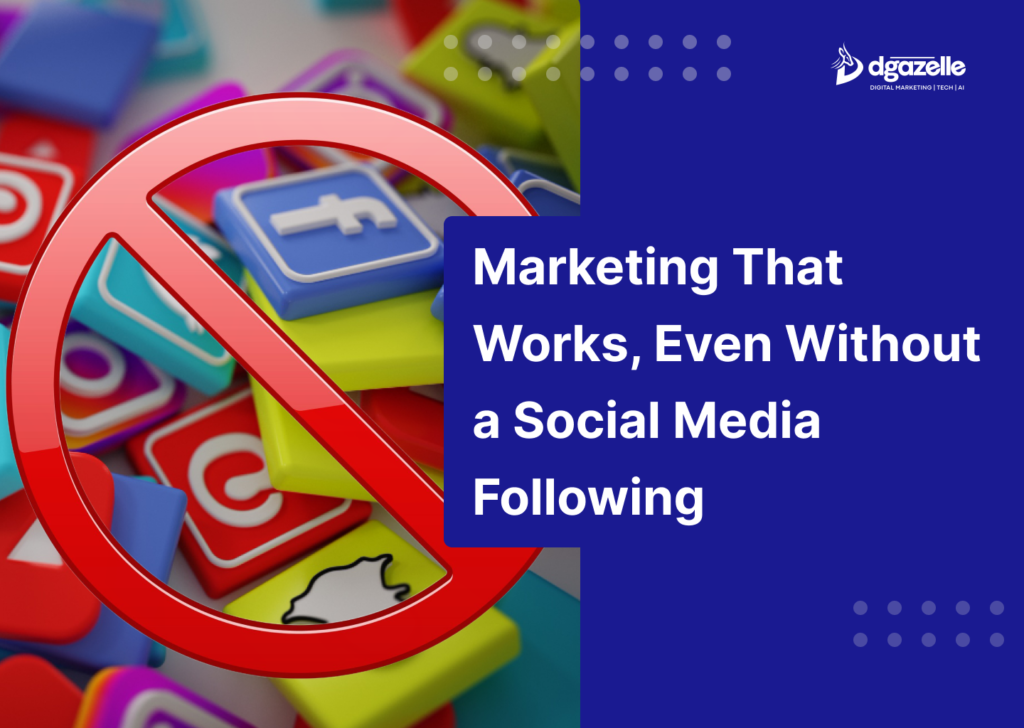
Running an online business without social media presence? Sounds like the punchline of a joke, right? Let’s be real — quitting social media can feel like stepping off a cliff without a parachute. You might wonder, “How will I get leads for my business? What happens to my marketing now?” That’s exactly why we’re here — to craft a foolproof marketing strategy that doesn’t rely on social media but still drives growth, conversions, and engagement. Imagine confidently saying goodbye to endless posting, algorithm battles, and burnout — without a single backward glance. To be clear, none of us at Dgazelle are against using social media. It can be a source of fantastic connections, a creative outlet, or just plain fun to use. In fact, several of my own closest real life friends I met on Twitter years ago! However, social media is absolutely not necessary to build and grow a successful business in 2025. Many SMEs have built successful brands by leveraging alternative digital marketing strategies — and you can too. Finding the Right Marketing Strategy for Your Business (Without Social Media) You can’t stepped away from Instagram, Facebook, and all the rest, without having solid marketing strategies already in place. So before you say “Adios” to Instagram, Facebook, X, or TikTok, it’s crucial to ask yourself: What marketing strategy will replace social media? What foundations will you start building today so that you’re ready for tomorrow? Let’s make this decision intentionally. You’re investing time, money, and energy into a strategy that could serve your business for years. Just like financial investments, marketing requires strategic thinking. Imagine standing at a financial crossroads: Choosing between these isn’t about “crypto versus real estate.” It’s about understanding your overall investment strategy — what’s your risk tolerance, desired involvement, and long-term goals? The same goes for choosing marketing strategies: Email marketing, SEO, and traditional advertising are all tools — but your decision hinges on your business objectives and audience needs. By starting with a clear strategy, you’ll select the right marketing tools and confidently say goodbye to social media without scrambling back months later because you’re desperate for leads. So, here’s the game plan: define your strategy, then pick your tools. Social media is just one option — but for you, it’s off the table. Ready to build a thriving business without social media? Let’s explore various approach. 1. Ask for Referrals Never underestimate the power of a good referral. Happy clients can become your biggest marketing allies. Here’s how to leverage this strategy: For instance, I’ve landed multiple projects just by asking satisfied clients to refer me to their networks. Referrals are proof that word-of-mouth marketing still works wonders. 2. Create an SEO-Friendly Website A website is your business’s permanent address online, driving credibility, trust, and visibility. In fact, SEO drives over 1,000% more traffic than organic social media, with 68% of online experiences starting with a search engine. Key benefits of having a website: Don’t have a website yet? Start simple on platforms like WordPress, which offers beginner-friendly templates and self-hosting. Or invest in a professional website developer for a more robust solution. 3. Blog Consistently Once your website is up, consistent blogging becomes a powerful tool to drive traffic and conversions. Valuable blog content helps you rank on search engines, offering solutions your audience is actively searching for. Over time, I found that blog articles led to higher conversions. Why? People searching on Google are often ready to buy, unlike social media users who are in a passive browsing state. Consider your own behavior: when searching for services or products, do you rely on social media or Google? Most turn to Google with queries like “budget-friendly travel destinations” or “clean skincare products.” Blogging positions your brand to appear on search results and answer user queries, guiding readers toward your offers. 4. Host Workshops Workshops allow you to showcase your expertise, raise brand awareness, and attract potential clients or customers. You can lead your own workshop or collaborate with other businesses. For example, as an SEO consultant, I might host a workshop on “How to Grow Your Business with Website SEO.” Here are other workshop ideas based on business types: Hosting workshops provides value to your audience while positioning you as an industry leader. 5. Pitch Podcasts Did you know 40% of podcast listeners make purchases after hearing recommendations on a podcast? Pitching podcasts with relevant audiences can elevate your brand visibility. When featured, you typically share insights, answer questions, and promote offers at the end of the episode. Tips for a successful pitch: Being authentic and engaging on podcasts builds trust and connects you with potential clients or customers. How to Grow a Business Without Social Media Step 1: Evaluate Your “Why”Reflect on why you want to grow your business without social media.Common challenges include: If you’re seeking diverse lead sources, feel burnt out by social media, or have seen poor ROI, exploring alternatives may be beneficial. Step 2: Understand Your Audience DeeplyKnowing your audience’s problems and aspirations is key to effective off-social marketing. Exercise: Visualize your ideal client who achieved great results. This exercise provides insights for tailored messaging and offers. Step 3: Develop a Body of WorkCreate foundational content to establish your authority. Steps to build authority: Step 4: Build an SEO-Based Marketing FunnelDid you know 90% of online experiences start with search engines? Ignoring search limits your reach. Here’s how a search-focused funnel works: Keep it simple. Don’t overcomplicate the process—focus on solving searchers’ problems. Step 5: Build Referral NetworksNetworking with both colleagues and competitors is a powerful, overlooked strategy. Tips for building referrals: A strong referral network can drive high-quality business from aligned clients. Step 6: Experiment and Track Metrics for Non-Social MarketingFear of trying new marketing strategies often stems from uncertainty. However, experimenting allows you to gather valuable data, helping refine your approach over time. Tips: Data-driven experiments reduce the guesswork in your marketing journey. Step 7: Collect Data and Refine StrategiesAfter at least 90
Programmatic SEO Made Simple: Transform Your Approach to Search Engine Strategy
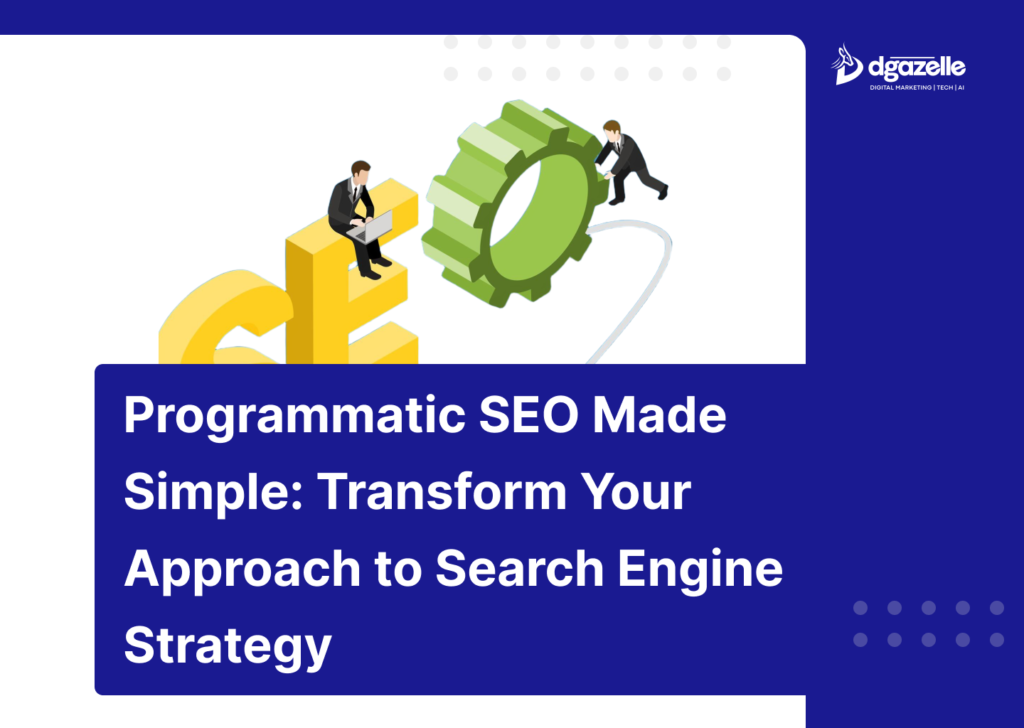
Ever wondered how some websites effortlessly rank for thousands of keywords without a huge content team? That’s the magic of programmatic SEO. With AI increasingly on the rise, automation are game-changers. Programmatic SEO empowers businesses to generate hundreds—even thousands—of optimized pages at scale, saving valuable time while driving significant search visibility. Instead of relying solely on manual tactics, it uses data-driven insights to spot trends, automate optimization, and boost results. But here’s the catch—it’s not for everyone. To unlock its full potential, you need a clear strategy tailored to your business goals. Looking to outsmart your competitors with smarter, scalable SEO tactics? Partner with our digital marketing experts to craft a winning programmatic SEO strategy designed to amplify your search rankings and drive growth. What is Programmatic SEO? Programmatic SEO is an approach to search engine optimization that uses automation to create large numbers of pages, each targeting specific, low-competition keywords. For instance, travel aggregator sites like Expedia effectively use programmatic SEO by generating location-specific pages for flights, hotels, and tourist activities based on structured data. Unlike traditional SEO, where content is manually crafted for each keyword, programmatic SEO relies on templates and automation tools to generate hundreds—or even thousands—of pages at scale. This method is particularly useful for businesses offering a wide range of products, services, or content topics. What’s made programmatic SEO even more accessible today is the rise of AI and automation tools like GPT-4, Frase, and SurferSEO. GPT-4 helps generate detailed base content efficiently, Frase aligns it with user intent to improve engagement, and SurferSEO provides data-driven keyword insights to optimize content performance. When executed with the right data and automation setup, programmatic SEO can drive serious traffic at scale. Summarizing the advantages of automation and data-driven insights, it’s important to acknowledge potential downsides. Programmatic SEO isn’t for everyone. It works best for websites that provide unique, relevant data across a large set of similar keywords. Without quality data and a clear strategy, thin, low-value content can harm your rankings instead of boosting them. To mitigate this risk, prioritize high-quality content by using robust templates, incorporating user-focused information, and maintaining data accuracy. Programmatic SEO vs. Traditional SEO The key difference between programmatic SEO and traditional SEO lies in execution and scalability—both of which have implications for small and medium-sized enterprises (SMEs). Traditional SEO focuses on crafting high-quality, targeted content for individual keywords through meticulous user research, manual content updates, and in-depth optimization. This hands-on approach aims to satisfy search intent for highly specific queries, often requiring significant time and creative resources. On the other hand, programmatic SEO is designed for efficiency and scale. Instead of manually creating pages for each keyword, businesses develop templates and use automation to generate hundreds or even thousands of pages targeting long-tail keywords. This approach works particularly well for SMEs managing diverse product catalogs, service directories, or niche content categories. For example, an SME running an e-commerce store can use programmatic SEO to create dynamic product pages that incorporate essential elements like pricing, customer reviews, and specifications. Similarly, a real estate directory can generate location-specific listings by leveraging structured data. Both approaches hinge on strong keyword research—without it, any SEO effort will falter. However, programmatic SEO requires additional attention to data accuracy and content quality to prevent thin, low-value pages. SMEs adopting this strategy should ensure their content templates provide meaningful user experiences and valuable information. Here’s a refined version of the “Potential Benefits of Programmatic SEO” section optimized for SEO and SME business owners: Benefits of Programmatic SEO One of the most impactful advantages of programmatic SEO is its efficiency. For SMEs with limited time and resources, this approach offers a way to generate a vast number of keyword-focused pages without the heavy cost of manual content creation. Automation allows you to scale up and create hundreds or even thousands of pages quickly, saving valuable time and operational expenses. This approach also helps capture organic traffic that competitors might overlook by targeting low-competition, niche keywords. For example, a local service provider or product-based business can create pages optimized for specific locations or services, expanding their reach and authority across multiple regions. Moreover, programmatic SEO boosts your website’s visibility. By increasing the number of indexed pages, businesses gain more opportunities to appear in search results, attract new customers, and establish their online authority. When executed strategically, it can complement traditional SEO efforts and maximize your site’s organic growth potential. How to Set up Programmatic SEO Now that you’re familiar with programmatic SEO, let’s break down an actionable, step-by-step process to help SMEs efficiently scale their search visibility. With the right approach, this method becomes manageable and highly rewarding. 1. Identify Strategic Keywords Effective programmatic SEO begins with smart keyword research. Identify niche, low-competition long-tail keywords relevant to your industry. Tools like Ubersuggest or SEMrush are valuable for generating keyword lists. For SMEs, focus on terms with high purchase intent or location-based searches, such as “affordable marketing services in [city]” or “best digital tools for [sector].” 2. Create Flexible Page Templates Develop a template for dynamic page creation. Keep it clean and user-friendly, with placeholders for elements like product prices, service descriptions, or city-based content. This template becomes the framework for generating multiple SEO-optimized pages while maintaining consistent branding and functionality. 3. Leverage High-Quality Data Sources Accurate, relevant data elevates your pages. SMEs can use internal databases, publicly available datasets, or carefully vetted external sources to populate dynamic content fields. Ensure your data stays up to date—whether it’s pricing, locations, or service descriptions—to maintain user engagement and search relevance. 4. Automate Page Generation Automation is the heart of programmatic SEO. Use tools like Google Sheets combined with WordPress plugins (e.g., WP All Import) or Webflow to dynamically populate page templates. This process can help SMEs create hundreds of keyword-focused pages quickly, without sacrificing consistency or functionality. 5. Optimize and Improve Continuously Automation doesn’t mean set-and-forget. Regularly review metrics like bounce rate, average time on page, and CTR to identify areas for
Search Everywhere Optimization: Why Traditional SEO Is No Longer Enough
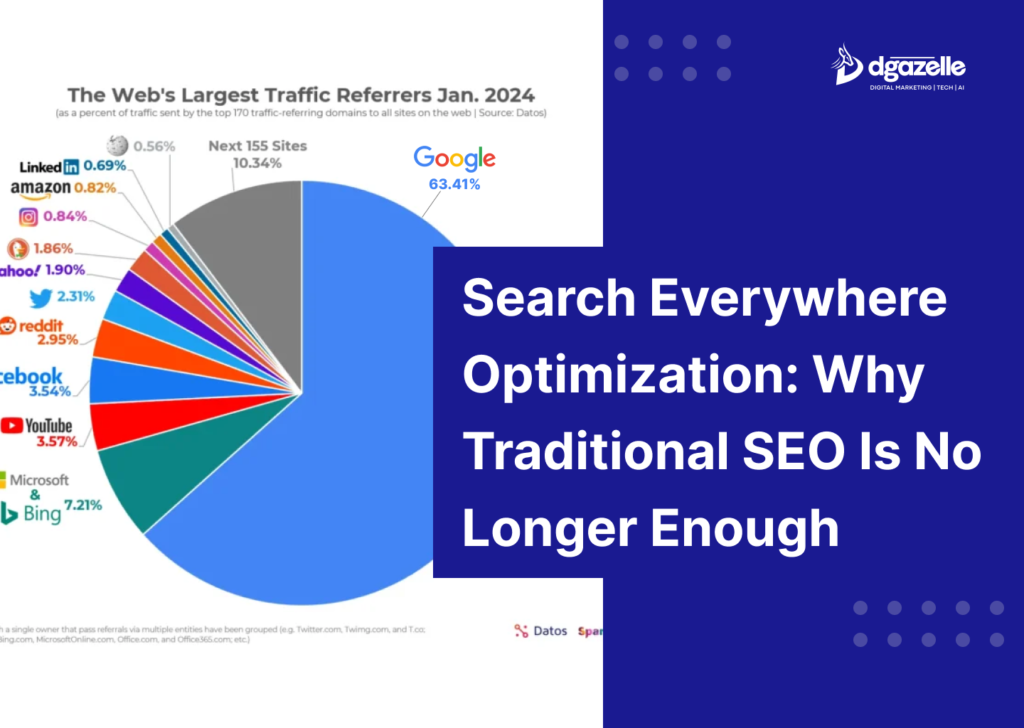
The search space is fracturing. Google, once the king of search engines, is no longer always the first stop for people seeking answers. Increasingly, users are turning to platforms like social media, YouTube, Amazon, and even AI-powered tools like ChatGPT. These platforms have become their own search engines, shifting the way people discover content. For businesses, this means one thing: traditional SEO is no longer enough. Search Engine Optimization needs to evolve beyond Google. To truly succeed, brands must optimize their presence across all digital touchpoints, from social media to video platforms. Welcome to the world of Search Everywhere Optimization. This comprehensive approach helps businesses ensure they’re visible wherever people are searching, across a wide variety of platforms. At Dgazelle Digital, we specialize in building cohesive digital strategies that boost your brand’s reach across these diverse channels. In this article, we’ll dive into why Search Everywhere Optimization is critical for your business, where to focus your efforts, and how to enhance your presence across key platforms. Ready to step up your visibility? Let’s explore!’ What Is Search Everywhere Optimization and Why Your Brand Needs It Now Search Everywhere Optimization is a revolutionary strategy reshaping how brands approach online visibility. At Dgazelle Digital, we’re embracing this holistic approach to ensure our clients are discoverable across the digital ecosystem — not just on Google, but on social media, video platforms, eCommerce sites, and AI-driven tools. Why does this matter? The way people search has evolved. They’re seeking recommendations on Instagram, tutorials on YouTube, products on Amazon, and quick answers from AI assistants. Limiting your optimization to one platform leaves you invisible where potential customers are actively searching. Here’s what Search Everywhere Optimization can do for your business: At Dgazelle Digital, we combine website design, social media management, digital marketing, branding, and business consultation to execute search everywhere optimization strategies. Let us help you build a resilient, multi-platform presence that turns searches into conversions. My Experience: Discovering Restaurants on Instagram When searching for restaurants, I find Instagram far more useful than Google. Let me share a quick story. The last time I wanted a good place to eat in Lagos, I didn’t even think of using Google. I went straight to Instagram and searched for #LagosFood. Instantly, my feed was filled with beautiful, mouth-watering images from all kinds of restaurants in the city. What makes Instagram better? These aren’t promotional pictures from restaurants. They’re real photos taken by foodies, bloggers, and regular people who’ve actually eaten there. You see the food exactly how it looks when served, not just polished menu shots. Even better, posts often include location tags and comments filled with reviews, making it easy to decide where to go. Thanks to Instagram, I found a fantastic spot, and the experience didn’t disappoint. This is why brands must optimize their social media presence — it’s where customers are searching today! The Power of Reviews and Community Engagement One thing I love about social media searches is the community vibe. On Google, reviews often feel impersonal — just blocks of text from people you don’t know. Platforms like Instagram and TikTok offer something richer: authentic reviews from real people sharing personal experiences. Even better, these reviews spark engagement in the comments. For instance, a foodie might post about a restaurant, and followers will share their own tips or ask questions. The original poster often responds, creating a mini-community of food lovers helping each other out. On TikTok, this engagement is even more dynamic. Videos are filled with comments, suggestions, and shared experiences — a far more interactive way to find recommendations. It’s no longer just about finding information; it’s about connecting with a like-minded community. Brands that foster engagement on social platforms can build trust and loyalty like never before. What This Means for Brands: Adapting to the New SEO The shift to search everywhere optimization is a wake-up call for brands. Google SEO alone won’t cut it anymore. Today’s customers search across multiple platforms — from Instagram to TikTok to AI. If your business isn’t showing up there, you’re invisible to your audience. Here’s how your brands can adapt to the change: 1. Create Engaging Visual ContentDon’t just focus on aesthetics — create purpose-driven visuals that resonate with your audience. High-quality videos, reels, and carousel posts can boost engagement and amplify your reach on social platforms. We can help you craft attention-grabbing visuals that align with your brand identity and message. 2. Leverage Hashtags and Geotags StrategicallyHashtags and geotags increase discoverability. Research trending hashtags your audience follows and add location tags to boost visibility for local searches. Dgazelle Digital helps brands unlock this potential with tailored social media strategies for maximum impact. 3. Collaborate with InfluencersInfluencers already have established, loyal communities that trust their opinions. By partnering with influencers, brands can gain authentic endorsements that feel more personal and relatable than traditional ads. The key is choosing influencers whose values and audience align with your brand’s mission to foster genuine connections and drive long-term engagement. 4. Encourage and Amplify User-Generated Content (UGC)User-generated content is a powerful tool for building credibility. When customers share their experiences, it feels authentic and trustworthy, often encouraging others to follow suit. Brands can motivate UGC through campaigns, contests, and active engagement with their audience’s content. Dgazelle Digital can help you strategically launch UGC initiatives, turning your customers into advocates and boosting your visibility across social platforms. Overcoming Search Everywhere Optimization Challenges While Search Everywhere Optimization sounds promising, implementing it comes with challenges. Here’s how to tackle them head-on: 1. Limited Resources Most businesses can’t afford to optimize their presence across every platform at once.Solution: Prioritize platforms your audience frequents. Analyze website traffic sources and focus your efforts where they’ll make the biggest impact. Gradually expand as your resources grow. 2. Changing Algorithms Social platforms constantly update their algorithms, making it hard to stay relevant.Solution: Stay adaptable. At Dgazelle Digital, we monitor platform changes, ensuring our clients’ strategies remain effective across all channels. 3. Balancing Platform-Specific
Content Atomization: How to Make One Piece of Content Work 10X Harder
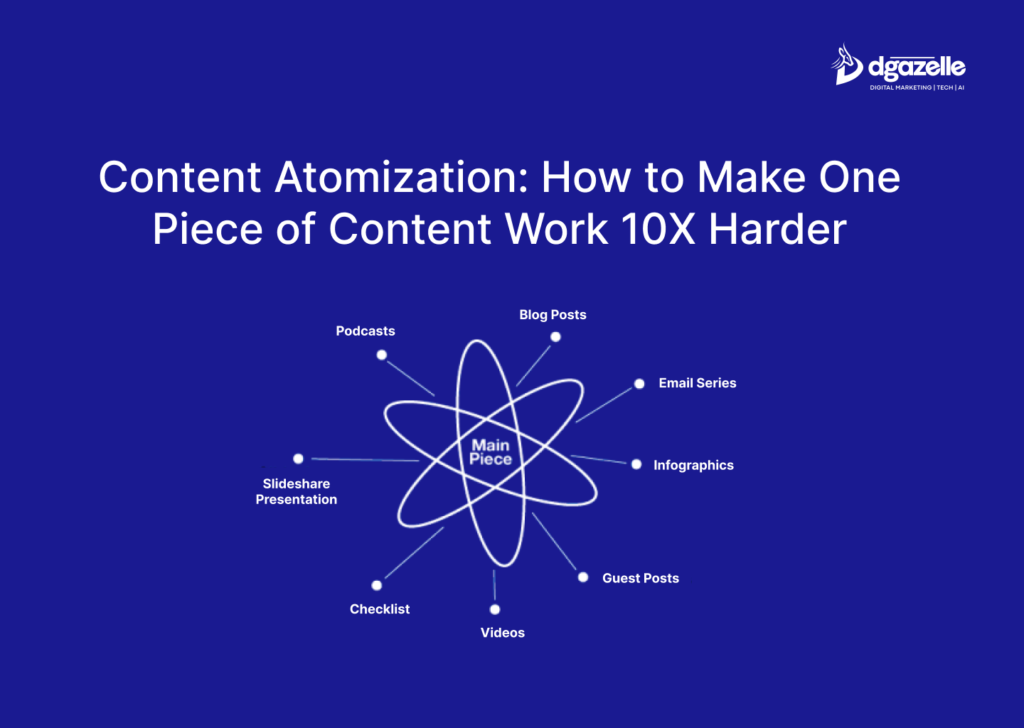
Has your content ever been a one-hit wonder? You know — that one blog post or video that did great, then vanished into digital obscurity? If so, you’re probably sitting on a goldmine without realizing it. Creating great content takes time and effort. You brainstorm ideas, research key phrases, check competitors, write, optimize, design graphics, and promote — only for it to fade away after a few clicks and shares. Exhausting, right? And the thought of starting from scratch again feels like running on a never-ending content treadmill. But here’s the good news: You don’t need to keep creating content from scratch to make an impact. What if you could take that one piece of content — your best-performing blog, webinar, or podcast episode — and multiply its reach across multiple channels without sounding repetitive? That’s where content atomization comes in. Think of it like turning a single brick into an entire building. You break down one core content piece into several smaller, tailored pieces that fit various platforms and audience preferences. As content marketing expert Joe Pulizzi puts it: “The easiest way to turn off your community is to broadcast the same message across multiple channels. Instead, determine the kind of content that interests your audience in a way that’s useful to them.” So, what’s the smarter way to approach content? It’s time to ditch the “create once, use once” approach. Content atomization helps your content work harder, last longer, and reach farther — all while saving you time and maximizing your ROI. What Is Content Atomization? Making One Idea Work Harder Imagine squeezing every last drop of value from a great piece of content — that’s content atomization in action. It’s a powerful way to multiply your content’s impact without multiplying your workload. At its core, content atomization involves taking one big content idea and breaking it into smaller, more digestible pieces that can live across multiple platforms. Whether it’s turning a blog post into a video series, an infographic, or social media posts — you get more reach without reinventing the wheel. Why Content Atomization Works: The Key Benefits Content Atomization vs. Content Repurposing: What’s the Difference? At first glance, content atomization and content repurposing sound like the same thing. Both involve adapting existing content, but the difference lies in the execution: Let’s clarify this with a practical example: Why Both Strategies Matter The best content marketers use both atomization and repurposing to maximize their efforts. While repurposing keeps your core content alive in different formats, atomization allows you to dive deeper into key ideas, creating fresh content that resonates across multiple channels. When done right, content atomization turns your hard work into an ongoing content goldmine — driving visibility, engagement, and conversions without the constant hustle of creating from scratch. How to Atomize Content: Step 1: Choose a Strong Pillar Piece Successful content atomization starts with selecting the right foundation—a pillar piece that provides plenty of material to break down and repurpose. But not just any content will do. Your pillar piece should be: Why does pillar content matter? A weak pillar limits your atomization potential, leaving little room for creative repurposing. Instead, a well-chosen pillar ensures you have enough key insights to fuel an entire content strategy. Examples of great pillar content: ebooks, whitepapers, research reports, blog guides, or webinars. Step 2: Identify Core Themes and Subtopics Dissecting your pillar content is essential for successful atomization. To start, look for core themes, key takeaways, and hidden insights that can stand alone as valuable content pieces. Here’s how to do it: Step 3: Brainstorm Diverse Formats Now comes the creative part! Take the subtopics from your pillar content and imagine all the ways you can transform them into fresh, engaging content across various formats. Written Formats: Visual Formats: Beyond Written Content: Pro Tip: Consider your audience. What platforms do they use? What formats will resonate most? Build a format list for each subtopic to maximize content output. Step 4: Creation and Distribution Plan Now that you’ve brainstormed content ideas, it’s time to align them with your distribution strategy to ensure they connect with the right audience at the right time. Map Content to Platforms: Develop a Content Calendar: Repurpose with Purpose: Conclusion We’ve explored how content atomization can take your existing content and amplify its impact. By strategically breaking down and repurposing what you already have, you unlock its full potential. Content atomization isn’t about churning out endless new material. It’s about making smarter, more efficient use of what’s already working. This strategy can extend your reach, attract new followers, improve visibility, and solidify your position as a thought leader. The Bottom Line: Content atomization is about working smarter, not harder. Ready to make your content work 10X harder and achieve greater results? Start atomizing today and watch your content marketing soar! Ready to Make Your Content Work Harder? At Dgazelle Digital, we specialize in turning your existing content into a powerful engine for growth. If you’re ready to amplify your online visibility and position your brand as an industry leader, let’s talk. Partner with us and watch your content marketing efforts skyrocket! Get in touch today and let Dgazelle Digital help you atomize your content and achieve smarter, more efficient results.
5 Copywriting Techniques To Boost Your Website Conversion Rate

Did you know that nearly 70% of online businesses fail to convert their website visitors into customers? This staggering statistic underscores the crucial role of effective copywriting in driving conversions. If your website isn’t converting as it should, the problem may lie in your content. While both content and copywriting are essential for your business, there’s a key difference between the two. Copywriting is typically focused on driving immediate sales and actions—whether through ads, emails, social media posts, or landing pages. On the other hand, content aims to educate, inform, or provide value to your audience, often without a direct sales push. Whether you’re focusing on content or direct sales copy, there are strategies you can implement to turn more visitors into loyal customers. In this article, we’ll explore five powerful copywriting techniques that can significantly boost your website’s conversion rates, ensuring your visitors take action. Understanding SEO Content Writing Before delving into the techniques, it’s important to understand what SEO content writing is all about. At its essence, SEO content writing is the art of crafting content that is both valuable to your target audience and optimized for search engines. This involves creating high-quality, informative, and engaging articles, blog posts, or web copy that answer your audience’s questions or solve their problems. The key to effective SEO content writing is striking the perfect balance between relevance and optimization. Your content must be engaging and provide value to readers while also being structured to meet search engine algorithms’ preferences. This combination ensures that your website attracts both the right audience and the search engines, increasing your chances of success. Copywriting Techniques To Boost Your Website 1. Create Attention-Grabbing Headlines Your headline is the first thing visitors see, and it holds the power to either capture their attention or send them away. A headline needs to be clear, concise, and intriguing. It should compel the reader to want more. To achieve this, incorporate power words, action verbs, and numbers that promise specific value or outcomes. For example, instead of a vague title like “Writing Tips,” consider something more impactful, such as “5 Proven Tips to Write Copy That Converts.” This approach not only intrigues the reader but also provides a tangible benefit. An engaging headline serves as a hook, drawing readers into your content. It sets the tone for the rest of the page and encourages further exploration. Beyond the user experience, headlines also play a crucial role in SEO. Search engines prioritize relevant, attention-grabbing titles, helping your page rank higher and attract more visitors. By optimizing your headlines, you improve both user engagement and discoverability, ultimately driving higher conversions. 2. Emphasize Benefits Over Features When crafting website copy, it’s tempting to focus on listing the features of your product or service. However, the most compelling copy shifts the focus from features to benefits—the outcomes your audience will experience by using your product or service. Instead of simply stating, “Our software includes advanced analytics,” say something like, “Unlock actionable insights into your business performance with our advanced analytics, empowering you to make informed, data-driven decisions.” By emphasizing benefits, you help potential customers envision how your offering can address their specific pain points or improve their current situation. This shifts the conversation from technical specifications to real-life value, creating a deeper, emotional connection with your audience. When customers can see how your product will improve their lives, they’re more likely to convert. Highlighting benefits over features creates a stronger motivation to take action, enhancing the chances of a sale or lead generation. 3. Create Clear and Persuasive Calls to Action (CTAs) A strong call to action (CTA) plays a crucial role in guiding your website visitors toward the next step in their journey. Whether it’s “Subscribe Now,” “Start Your Free Trial,” or “Get Instant Access,” your CTA needs to be both clear and compelling. The key is to make it actionable—directing users toward a specific, desired outcome. To increase its effectiveness, use contrasting colors and place the CTA strategically in high-visibility areas of your page. A well-crafted CTA eliminates any confusion and provides visitors with a clear path to take action. It serves as a guide, making it easier for users to engage with your content and move forward in the sales funnel. By removing ambiguity and prompting action, an optimized CTA can dramatically boost conversion rates. It not only attracts attention but also motivates users to follow through, increasing the likelihood of achieving your business objectives. 4. Optimize Your Copy for SEO Incorporating SEO practices into your website copywriting is vital for enhancing visibility and driving more traffic to your site. This involves strategically using relevant keywords throughout your content, especially in headings, subheadings, and meta descriptions. Long-tail keywords, such as “how to optimize website content for higher conversions” or “SEO strategies for boosting website traffic,” are effective in targeting specific search queries. This targeted approach helps attract visitors who are more likely to engage with your content and convert into customers. By optimizing your content for search engines, you increase the likelihood of ranking higher in search engine results pages (SERPs). This boosts your online visibility, making it easier for potential customers to find you. The more visible and accessible your content is, the higher the chances of attracting organic traffic, which ultimately results in more opportunities to convert visitors into leads and sales. Proper SEO integration is a long-term investment for sustained growth. 5. Leverage Social Proof Social proof, including customer testimonials, case studies, and user reviews, is a powerful tool for boosting conversions. Displaying feedback from satisfied customers or sharing detailed case studies that highlight your product’s effectiveness can help establish credibility and trust with your audience. By showcasing real-life experiences, you demonstrate that your product or service delivers value, which can influence potential buyers’ decisions. People tend to trust the opinions and experiences of others when making purchasing decisions. When potential customers see that others have benefited from your product or service, it reduces uncertainty and
The Risk of SEO Over-Optimization in Website and How to Avoid it

Search engine optimization (SEO) is a powerful tool for increasing visibility and ensuring that your content, products, or services reach the right audience. When done correctly, it enhances your website’s ranking on search engines, helping potential customers discover your offerings. However, just like with anything, it’s possible to go too far with SEO—leading to what’s known as SEO over-optimization. Google has pointed out that while SEO is beneficial, there are limits. Over-optimizing a website can lead to penalties, diminishing its performance rather than improving it. Over-optimization occurs when excessive SEO tactics are applied to a website, making it harder for search engines to recognize and rank the page effectively. The result? What started as good practice can actually hurt your rankings. What Is Over-Optimization? Over-optimization in SEO occurs when you go beyond the necessary practices to push your website to the top of search results. This often happens when you overuse keywords, excessively link to the same phrases, or engage in tactics designed solely to manipulate search engine algorithms. While SEO is important for visibility, Google and other search engines penalize over-optimization because it can negatively impact the user experience (UX). A website that’s overly optimized may feel unnatural or stuffed with keywords, making it harder for visitors to navigate or engage with. This can lead to lower rankings or, in extreme cases, removal from search results altogether. Instead of focusing solely on search engines, it’s essential to create quality content that resonates with users and uses keywords and links naturally. By prioritizing human readers over bots, you can build a website that’s both search-friendly and user-centric. Why Is Over-Optimizing Bad for SEO? Over-optimizing can cause significant SEO issues because search engines may view it as an attempt to manipulate rankings, rather than offering genuine, valuable content. Search engines prioritize high-quality content that provides real value to users. If over-optimization leads to low-quality content that doesn’t meet users’ needs, it creates a poor experience. No one wants to click on a link only to find irrelevant or poorly-written content. This not only frustrates users but also undermines the credibility of search engines. Tactics like keyword stuffing or excessive link building violate Google’s spam policies and can result in penalties, manual actions, or even a drop in rankings. To avoid these risks, focus on creating content that is valuable, relevant, and user-friendly, rather than trying to game the system with excessive SEO tactics. Common Over-Optimization Practices to Avoid Understanding SEO best practices is crucial to avoid over-optimization. Here are some key pitfalls: De-Optimizing Content De-optimizing content is about identifying and fixing over-optimization issues to enhance both SEO and user experience. Begin by reviewing your content for overused or forced keywords, excessive anchor text optimization, and duplicate content. You can do this manually by carefully reading and comparing your content, or use a tool like Semrush On Page SEO Checker to analyze your site’s content. The On Page SEO Checker, among other metrics, automatically calculates your content’s keyword density (the ratio of keywords to total word count) and compares it to that of your top 10 competitors. Best Practices for SEO Optimization Conclusion In conclusion, successful SEO optimization involves striking the right balance between appealing to search engines and providing an excellent user experience. Over-optimization, where too much focus is placed on technical SEO, can make your site feel forced and lose sight of the bigger picture. While technical SEO is essential, the real impact comes from creating high-quality, engaging content that naturally integrates relevant keywords. At Dgazelle, we specialize in delivering tailored SEO strategies that improve your rankings and boost user experience. Contact us today to get started on enhancing your SEO with expert analysis, content optimization, and technical solutions that drive results!

